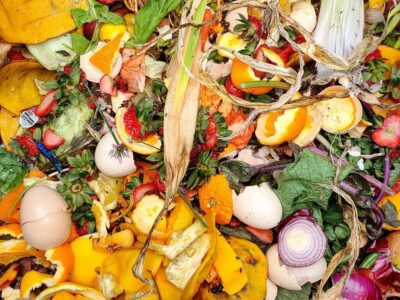
In Japan, all residents are responsible for sorting their trash into several waste streams. They are required to label clear garbage bags with their name and address, so the contents can be easily identified. If anything is sorted incorrectly, they will have their bag returned and be told to sort their trash correctly. This strict system has resulted in about 99 percent of Japan’s municipal waste being diverted from landfills.
As I walk past a wall of black garbage bags outside my Manhattan apartment building, I wonder: if a whole country can have such strict standards and rules for their citizens in disposing of their waste, why can’t New York City?
In 2015, Mayor Bill de Blasio set a goal of zero waste going to landfills by 2030, but little has been done since then to meet that goal. New York City produces 33 million tons of garbage per year, and most of it ends up in landfills. Compostable materials make up 1.1 million tons of that waste each year, or nearly a third of what we throw away from our homes.
Those leftover banana peels and avocado rinds are doing more than taking up limited space in landfills. New York City’s landfilled trash generates one million tons of greenhouse gases every year, and most of that comes from the breakdown of waste that could have been composted. Collecting and transporting the garbage to landfills outside of New York state requires trucks to drive 25 million miles a year, using 11 million gallons of diesel fuel, which also creates emissions.
The city must include compost as one of the waste streams that New Yorkers are required to separate alongside recycling. This needs to be mandated city-wide as soon as possible, not only to reach de Blasio’s 2030 goal, but for the health and longevity of our city and planet.
The city’s composting efforts to date have not met with glowing success. Since New York began its pilot voluntary curbside composting program in 2013, it has yielded high costs and low returns. In 2019, the last full year the program was in operation, it cost $32.2 million and diverted only 1.4% of waste from landfill to compost collection. The program stopped neighborhood expansion in 2018 and was halted entirely in 2020 to reallocate funds due to the COVID-19 pandemic.
However, a report by the Independent Budget Office of New York revealed that the main reason for the high cost is inefficient routes due to the low participation rates across the city, which drives up the cost per ton collected. Composting can cost the same or less than landfilling and recycling if there is more compostable waste being collected. A mandate would solve the problem of low participation.
There are some challenges to implementing a mandate. Many residents do not know that the city has a composting program or are not willing to change their habits. In addition, high-rise building managers are reluctant to add another waste stream to manage, especially one that may attract vermin.
However, these barriers can be dismantled relatively easily. The city can encourage residents to change their habits through expansion of educational programs and advertising that teach residents how to correctly sort their waste, as well as the benefits of composting. Reassurance must be provided to building managers that the compost bins provided by the city are vermin-proof, and that waste will be picked up frequently enough to avoid overflow.

Building the system to make a compost mandate viable will require a lot of resources, but should be considered a worthy investment for the future of New York City. Whereas landfilling waste only incurs costs at a rate that increases yearly as space runs out, composting can create usable materials for revenue. One million tons of compostable waste can generate $12.5 million in the sale of compost, or $22.5 million for the sale of biogas for electricity, according to another report by the Independent Budget Office.
Furthermore, composting can generate revenue through creating carbon offsets and averting greenhouse gas emissions. Although expanding composting will require more truck runs which generate more emissions, if almost all compostable waste were diverted, CO2 emissions would still be reduced by 657,000 tons per year and the city would avert $28 million in carbon social costs. Carbon social costs are the present monetary value of the future harm inflicted by releasing one additional ton of carbon into the atmosphere — for example, the cost of rebuilding areas at risk for flooding, or preventing an endangered species from becoming extinct due to climate change.
Last month, I was delighted to receive an email notifying me that there will be public compost drop-off bins in my neighborhood, but was later disappointed to find out that the installation of the bins was postponed indefinitely due to a collection issue. Still, I’m glad to see solutions for collecting compost in the works, even if progress is slow. Zero waste to landfills is within our reach. We just have to work harder for it.
Katherine Kam is a student in Columbia University’s Sustainability Management master’s program.
Views and opinions expressed here are those of the authors, and do not necessarily reflect the official position of the Columbia Climate School, Earth Institute or Columbia University.



